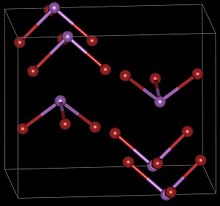
| |
| Names | |
|---|---|
| IUPAC name
tribromostibane
| |
| Other names
Antimony(III) bromide
| |
| Identifiers | |
3D model (JSmol)
|
|
| ChemSpider | |
| ECHA InfoCard | 100.029.254 |
| EC Number |
|
PubChem CID
|
|
| RTECS number |
|
| UNII | |
| UN number | 1549 |
CompTox Dashboard (EPA)
|
|
| |
| |
| Properties | |
| SbBr3 | |
| Molar mass | 361.472 g/mol |
| Appearance | colorless to yellow crystals hygroscopic |
| Density | 4.35 g/cm3 |
| Melting point | 96.6 °C (205.9 °F; 369.8 K) |
| Boiling point | 288 °C (550 °F; 561 K) |
| soluble,partial hydrolysis | |
| Solubility | soluble in dilute HCl, HBr, CS2, acetone, benzene, chloroform, ammonia, alcohol |
| -115.0·10−6 cm3/mol | |
Refractive index (nD)
|
1.74 |
| 2.47 D | |
| Structure | |
| Orthorhombic, oP16, SpaceGroup = Pnma, No. 62 (β form) | |
| Thermochemistry | |
Heat capacity (C)
|
96 J/mol K |
Std enthalpy of
formation (ΔfH⦵298) |
-259 kJ/mol |
| Hazards | |
| GHS labelling: | |
 
| |
| Warning | |
| H302, H332, H411 | |
| P261, P264, P270, P271, P273, P301+P312, P304+P312, P304+P340, P312, P330, P391, P501 | |
| Lethal dose or concentration (LD, LC): | |
LD50 (median dose)
|
7000 mg/kg |
| NIOSH (US health exposure limits): | |
PEL (Permissible)
|
TWA 0.5 mg/m3 (as Sb)[1] |
REL (Recommended)
|
TWA 0.5 mg/m3 (as Sb)[1] |
Except where otherwise noted, data are given for materials in their standard state (at 25 °C [77 °F], 100 kPa).
| |
Antimony tribromide (SbBr3) is a chemical compound containing antimony in its +3 oxidation state.
- ^ a b NIOSH Pocket Guide to Chemical Hazards. "#0036". National Institute for Occupational Safety and Health (NIOSH).